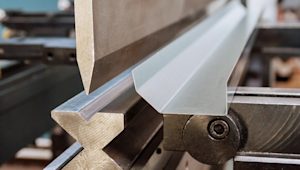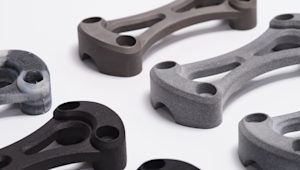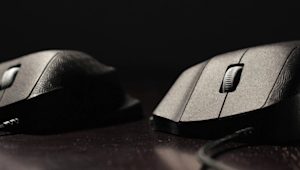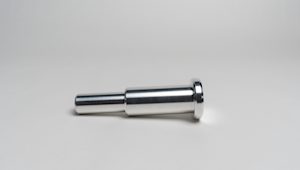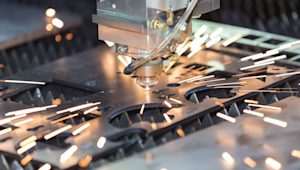In the past decade, 3D printing has gained popularity for its ability to create parts featuring complex geometries, reduce waste, and quickly produce customized parts. The technology, however, has predominantly been used for prototyping and small-scale production, due to its limitations in handling larger volumes of parts. In this article, we will explore the need for 3D printing technologies that can handle bridge and higher-volume production – and compare the various technologies available to achieve them.
What is bridge production?
Bridge production refers to the production of parts that fall between prototype and mass production quantities. These components are often produced in small quantities but require a fast turnaround time.
The bridge production process allows manufacturers to test their designs, gather feedback, and make necessary changes before investing in full-scale production. It's important to note that bridge production is not intended to be a long-term solution. Instead, it is a temporary measure that is used until full-scale production can begin.
Why should you use 3D printing for bridge production?
3D printing technology is a valuable tool for bridge production, as it offers numerous benefits that can help manufacturers streamline their development processes. Here are a few of them.
-
Speed. 3D printing allows manufacturers to quickly produce parts and products without the need for specialized tooling. This enables manufacturers to speed up the development process and get their products to market faster.
-
Flexibility. Because 3D printing is digital, it allows for greater flexibility in design and production. Manufacturers can easily make changes to their designs without having to create new tooling or molds, which can be time-consuming and costly.
-
Cost-effective. 3D printing technology can be a cost-effective solution for bridge production, as it eliminates the need for expensive tooling and molds. This makes it an ideal option for small production runs or custom products.
-
Reduced waste. Traditional manufacturing processes often result in significant material waste, as products are created by cutting away or removing excess material. 3D printing, however, creates products layer by layer, which reduces material waste.
What types of 3D printing are best suited for bridge production?
For bridge production, technologies such as fused deposition modeling (FDM), selective laser sintering (SLS), and stereolithography (SLA) are best suited.
-
Fused deposition modeling (FDM). A widely used 3D printing technology that works by depositing melted material layer by layer to create the desired shape, FDM is ideal for bridge production because it is cost-effective and can produce parts with relatively high accuracy.
-
Selective laser sintering (SLS). Another 3D printing technology that is ideal for bridge production, SLS uses a laser to melt powdered material, such as Nylon or polyamide, layer by layer to create the desired shape. SLS can produce parts with high accuracy and can handle even larger volumes of production than FDM.
-
Stereolithography (SLA). A 3D printing technology that uses a laser to cure liquid resin layer by layer to create a desired shape, SLA is ideal for bridge production because it can produce parts with high accuracy and with intricate geometries.
What are the advantages and disadvantages of 3D printing for bridge production?
Each 3D printing technology has its own advantages and limitations for bridge production. FDM, for example, is limited in terms of surface finish and accuracy, while SLA and SLS are more expensive and time-consuming. However, SLA and SLS are capable of producing parts with intricate geometries that cannot be achieved using FDM.
What is higher-volume production?
Higher-volume production refers to the process of manufacturing a larger quantity of products or parts in a production run. It is typically used for products that have already gone through the development and testing phases, and are ready for mass production.
Higher-volume production processes are designed to be efficient and cost-effective for producing large quantities of products with high precision and consistency. They also allow manufacturers to meet demand, reduce costs through economies of scale, and maintain consistent product quality.
The benefits of using 3D printing for higher-volume production
While 3D printing is often associated with low-volume production or prototyping, it can also be a viable option for higher-volume production in certain situations. Here are a few benefits of using 3D printing for higher volume production.
-
Cost-effective for complex designs. Traditional manufacturing methods may struggle with producing complex geometries, which can result in high costs due to the need for specialized tooling or multiple manufacturing steps. 3D printing, however, is capable of producing complex geometries in a single step, which can result in significant cost savings for higher-volume production.
-
Faster turnaround times. 3D printing allows for rapid production without the need for molds or tooling, which can significantly reduce lead times compared to traditional manufacturing methods. This means that companies can produce parts on demand and get products to market faster, reducing inventory costs and improving customer satisfaction.
-
Scalability. 3D printing allows for the easy scaling of production. By simply adding more printers, companies can quickly ramp up production without incurring significant capital costs for new equipment.
-
On-demand manufacturing. 3D printing enables on-demand manufacturing, meaning companies can produce parts or products only when they are needed, rather than having to stockpile large inventories. This can help reduce inventory costs, waste, and the need for storage space.
What types of 3D printing are best suited for higher-volume production?
For higher volume production, technologies such as binder jetting (BJ), direct energy deposition (DED), material jetting (MF), and multi-jet fusion (MJF) are best suited.
-
Binder jetting (BJ). A 3D printing technology that uses a liquid binder to bond powdered materials, such as metals or ceramics, layer by layer to create a desired shape. Binder jetting suits higher volume production because it can produce parts quickly and handle larger volumes of production.
-
Direct energy deposition (DED). DED works by depositing melted material layer by layer to create the desired shape. It can produce parts with high accuracy and can handle larger volumes of production than other technologies.
-
Material jetting (MJ). A 3D printing technology that uses inkjet printheads to deposit liquid material layer by layer to create a desired shape. MJ is ideal for higher volume production because it can produce parts with high accuracy and handle a wide range of materials.
-
Multi-jet fusion (MJF). MJF combines inkjet printing and powder fusion to create 3D objects. It is particularly well-suited for higher volume production because it allows for the creation of multiple parts in a single build, reducing production time and costs. Additionally, MJF can produce parts with high accuracy and consistency, which is critical for producing parts at scale.
What are the advantages and limitations of 3D printing for higher-volume production?
The advantages and limitations of each technology vary. BJ and MJF are limited in terms of material selection, while DED requires skilled operators and is more expensive. However, DED offers high accuracy and the ability to produce large parts that are difficult to achieve with other technologies.
To easily source parts for bridge production or higher-volume production, upload a CAD file to receive an instant quote and comprehensive DFM analysis.
You can learn more about how 3D printing works, including guides to the technologies mentioned in this article, as well as more about rapid prototyping and the potential for 3D printing in manufacturing.
Frequently asked questions
What are the best 3D printing technologies for bridge production?
FDM, SLS, and SLA are best-suited and often used for bridge production.
Which 3D printing technologies are suitable for higher-volume production?
Binder jetting, direct energy deposition, and multi-jet fusion are best-suited and often used for higher-volume production.
How do industries use 3D printing for bridge production?
3D printing for bridge production is commonly used for quick, cost-effective production of small production runs for testing and validation.
What industries use 3D printing for higher-volume production?
A growing number of industries are using 3D printing technologies for the mass production of products with high precision and consistency. These include the automotive, consumer goods, food and beverage, pharmaceuticals, and electronics industries.








